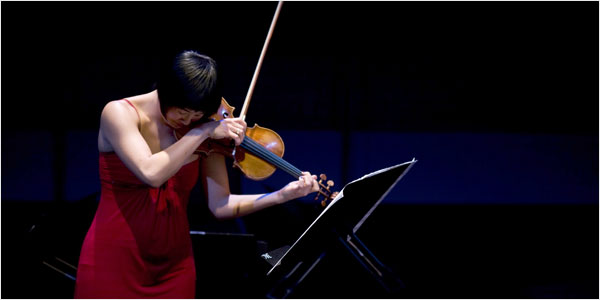The New York Times
By Allan Kozinn
February 10, 2009
original
link
Peering Into Complex Cloud Formations and Finding Sunshine
Music Review | Movado Hour Concert

The violin soloist Jennifer Koh (Konrad Fiedler for The New York Times)
Here’s a peculiar but fascinating double bill: in a Movado Hour concert at the Baryshnikov Arts Center on Monday, the Esterhazy Machine, a period-instrument group, played three Haydn baryton trios, and Jennifer Koh, the violinist, played thorny contemporary works. And to keep it fresh, Ms. Koh and the Esterhazy Machine played their music in alternation.
Even by the standards of period bands, baryton trios are oddities, not least because you don’t run into a baryton often. A bowed instrument, held like a cello, a baryton has added strings that vibrate sympathetically when the main strings are played. Kenneth Slowik, the group’s barytonist, demonstrated its unusual resonance, a kind of lingering harmonic haze. His colleagues were Steven Dann, the violist, and Myron Lutzke, the cellist.
Haydn’s works for this low-lying combination are courtly and danceable (most include a graceful minuet), if neither as virtuosic nor as colorful as some of the piano trios. The group played Trios in A, A minor and C (Hob. XI:71, 87 and 101), and if the performances were sometimes rough-hewn, they had an endearing liveliness. The ensemble was at its best, in fact, when the music was unusually involved, as in the triple fugue that closes the C Major Trio. The juxtaposition of these pieces and the contemporary scores that Ms. Koh played would have been wrenching not long ago, but now such style-hopping is so commonplace that a listener hardly has to adjust. If the pianist Pierre-Laurent Aimard can spend a recital moving from Bach to Elliott Carter and back, as he did at Zankel Hall last week, why should the smaller leap from Haydn to Mr. Carter be a problem?
Ms. Koh wandered in Bach’s direction, indirectly, by way of Ornette Coleman’s Fantasy for Solo Violin. An overtly tonal work with a gentle melodic core, the piece draws on melodic and rhythmic figures that seem to allude, however unspecifically, to passages in Bach’s unaccompanied sonatas and partitas.
The Coleman was the third work in a set that began with Mr. Carter’s “Statement — Remember Aaron” and “Riconoscenza per Goffredo Petrassi,” the first two of his “Four Lauds.” These are tightly compressed, brashly assertive portraits, and Ms. Koh played them with athletic precision.
She did the same for John Zorn’s “Goetia,” in which vigorous sliding, plucking, buzzing and tremolando bowing, all evoking an electronic timbre, occasionally gave way to a pure, singing violin line.
© 2009 The New York Times
© Jennifer Koh, All Rights Reserved. Photography by Juergen Frank. Site by ycArt design studio